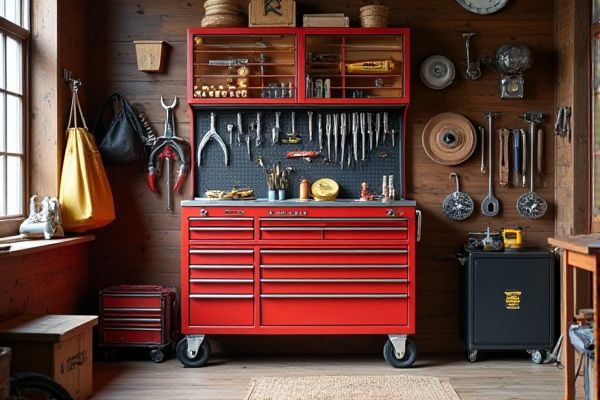
A toolbox is a compact, portable container designed to store and organize hand tools, ideal for easy transport and quick access during small projects. A tool cart, on the other hand, offers larger storage capacity with multiple drawers and wheels, providing mobility and ample space for extensive tool collections; discover which option best suits Your needs by reading the rest of the article.
Table of Comparison
| Feature | Toolbox | Tool Cart |
|---|---|---|
| Portability | Highly portable, compact size | Less portable, wheels for easier movement |
| Storage Capacity | Limited storage space | Large storage with multiple drawers |
| Weight | Lightweight, easy to carry | Heavier due to size and construction |
| Organization | Basic organization with compartments | Advanced organization with drawers and trays |
| Usage | Ideal for small jobs and quick tasks | Suitable for extensive workshops and professional use |
| Price | Generally lower cost | Higher cost due to size and features |
Toolbox vs Tool Cart: Key Differences
A toolbox is a compact, portable container designed for storing and organizing hand tools, often featuring multiple compartments and a handle for easy transport. In contrast, a tool cart is larger, typically equipped with wheels and multiple drawers, providing extensive storage and mobility for heavier tools in workshops or garages. Tool carts offer greater capacity and accessibility, whereas toolboxes prioritize portability and convenience for on-the-go use.
Storage Capacity Comparison
Tool carts typically offer greater storage capacity compared to toolboxes, featuring multiple drawers and compartments that accommodate a wide variety of tools and equipment. Toolboxes are generally more compact and portable, designed for easy transport but limited to fewer tools. The choice between the two depends on the balance between mobility needs and the volume of tool storage required for specific tasks.
Portability and Mobility Features
Toolboxes offer compact and secure storage, ideal for portability and quick transport of smaller tool collections, often featuring a handle for easy carrying. Tool carts provide enhanced mobility with wheels and larger storage capacity, making it easier to move extensive tools around a workspace, especially in garages or workshops. Your choice depends on whether you prioritize lightweight transport or the convenience of rolling heavy-duty storage.
Organization and Accessibility
Toolboxes offer compact storage with individual compartments that keep your tools neatly organized and easy to find. Tool carts provide larger, mobile storage with multiple drawers and surfaces that enhance accessibility by allowing you to bring your tools directly to the workspace. Choosing between them depends on whether you prioritize portability and segmented organization or expansive accessibility and workspace integration.
Durability and Material Strength
Toolboxes are typically made from sturdy materials like steel or heavy-duty plastic, providing exceptional durability and resistance to impact and wear. Tool carts often incorporate reinforced steel frames and heavy-gauge materials, offering enhanced load capacity and structural strength for frequent movement and heavier tool storage. The choice between the two depends on whether portability with solid protection or robust support for heavier equipment is prioritized.
Suitability for Different Trades
Toolboxes offer compact, organized storage ideal for trades like electricians and mechanics who require portability and easy access to small hand tools. Tool carts provide larger, mobile storage solutions suitable for automotive technicians and carpenters needing to transport heavy power tools and bulky equipment across job sites. Selecting between a toolbox and a tool cart depends on the specific storage capacity, mobility, and tool accessibility demands of the trade.
Cost and Budget Considerations
Toolboxes generally have a lower upfront cost compared to tool carts, making them a budget-friendly option for individual users or small workshops. Tool carts, while more expensive, offer greater storage capacity and mobility, which can lead to cost savings by improving workflow efficiency in larger operations. Investing in a tool cart may be more economical long-term for businesses requiring frequent tool access and transport.
Ergonomics and User Comfort
Toolboxes provide compact storage with a fixed handle, which can be less ergonomic for prolonged transport, while tool carts typically feature wheels and adjustable handles to reduce strain and enhance user comfort. The mobility of tool carts minimizes lifting and carrying, making them ideal for extensive use in workshops or job sites. Ergonomically designed tool carts promote better posture and reduce fatigue during tool access and movement compared to traditional toolboxes.
Security Features and Safety
Toolboxes often provide enhanced security features such as lockable lids with sturdy metal clasps to safeguard your tools from theft and unauthorized access. Tool carts, while typically equipped with lockable drawers, may offer less comprehensive protection due to their multiple compartments and mobility, requiring additional locking mechanisms or padlocks for optimal security. Prioritizing proper locking systems and secure storage locations on your tool container ensures maximum safety for your valuable equipment.
Choosing the Right Option for Your Needs
Selecting the right storage depends on your workspace size and tool collection; toolboxes offer portability and compact organization ideal for small sets, while tool carts provide larger capacity and mobility suited for extensive, frequently used tools. Consider the weight and frequency of tool access--toolboxes are lighter and easy to carry, whereas tool carts often feature wheels and multiple drawers for quick retrieval. Evaluate your workflow requirements and storage space to balance convenience, capacity, and accessibility when deciding between a toolbox and a tool cart.
 homyna.com
homyna.com